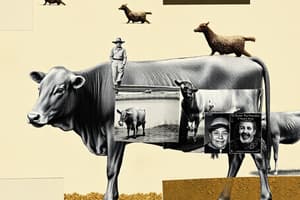Podcast
Questions and Answers
What is the main function of saliva in the ruminant digestive system?
What is the main function of saliva in the ruminant digestive system?
Saliva's most important function is to buffer pH levels in the reticulum and rumen.
What distinguishes ruminants' teeth from those of monogastrics like swine and poultry?
What distinguishes ruminants' teeth from those of monogastrics like swine and poultry?
Ruminants have premolars and molars that match between upper and lower jaws, allowing them to better use energy from fibrous plant material.
Why is the ruminant digestive system designed to ferment feedstuffs?
Why is the ruminant digestive system designed to ferment feedstuffs?
The digestive system of ruminants is designed to ferment feedstuffs to provide precursors for energy for the animal to use.
What is the significance of understanding the digestive system of ruminant animals for livestock producers?
What is the significance of understanding the digestive system of ruminant animals for livestock producers?
How much saliva can a mature cow produce per day?
How much saliva can a mature cow produce per day?
What are the four compartments of the ruminant stomach?
What are the four compartments of the ruminant stomach?
How do ruminants use their mouth and tongue during grazing?
How do ruminants use their mouth and tongue during grazing?
What is the purpose of the esophagus in ruminants?
What is the purpose of the esophagus in ruminants?
How do ruminants use their saliva during feeding?
How do ruminants use their saliva during feeding?
What is the role of the reticulorumen in the digestive process of ruminants?
What is the role of the reticulorumen in the digestive process of ruminants?
Flashcards are hidden until you start studying
Study Notes
Saliva and Its Functions
- Saliva aids in the initial breakdown of food, facilitating swallowing and digestion in ruminants.
- It provides lubrication for food, preventing damage to the esophagus during the feeding process.
- Saliva contains bicarbonate, which helps to buffer acids in the rumen, maintaining optimal pH levels for microbial function.
Distinctive Dental Structure
- Ruminants possess a unique dental structure that includes a dental pad instead of upper incisors, in contrast to monogastrics like swine and poultry that have full sets of teeth.
- The molars of ruminants are designed for grinding, contributing to efficient particle size reduction for fermentation.
Importance of Fermentation
- The ruminant digestive system is specialized for fermentation, allowing animals to break down fibrous plant materials more effectively, enhancing nutrient absorption.
- Fermentation occurs in the reticulorumen, where a diverse microbial population assists in digesting complex carbohydrates.
Significance for Livestock Producers
- Understanding ruminant digestion is crucial for optimizing feeding strategies, improving animal health, and maximizing production efficiency in livestock agriculture.
- Knowledge of ruminant digestive physiology can guide the formulation of diets that enhance fermentation and nutrient utilization.
Saliva Production
- A mature cow can produce between 50 to 150 liters of saliva per day, depending on factors such as diet and hydration levels.
Compartmentalized Stomach Structure
- The ruminant stomach consists of four main compartments: the rumen, reticulum, omasum, and abomasum, each playing a distinct role in digestion and nutrient absorption.
Grazing Mechanics
- Ruminants use their mouths and tongues to grasp and manipulate grass and forage efficiently, allowing for optimal grazing and feeding habits.
Role of the Esophagus
- The esophagus in ruminants serves as a conduit for food, allowing for the return of ingested material to the mouth for re-chewing (rumination) to enhance digestion.
Saliva Utilization During Feeding
- During feeding, ruminants utilize saliva for lubrication and as a source of enzymes that begin the digestion of carbohydrates.
Reticulorumen's Digestive Role
- The reticulorumen is critical for the fermentation process, hosting billions of microorganisms that break down complex feedstuffs into simpler compounds suitable for nutrient absorption.
Studying That Suits You
Use AI to generate personalized quizzes and flashcards to suit your learning preferences.




